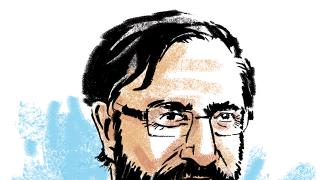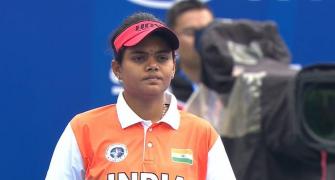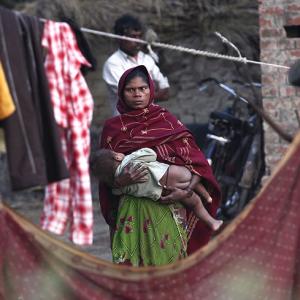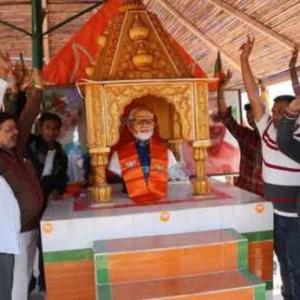'Government supplied public services are less likely to be found in neighbourhoods with high numbers of Scheduled Castes and Muslims.'

Discrimination on the basis of caste and religion in housing societies is something that many Indians may have experienced.
Now a new working paper on residential segregation in India has been published, which amplifies this fact with the exact figures.
The paper written by Paul Novosad, a professor at Dartmouth university in the US, and founder of devdatalab.org (external link); Sam Asher (associate professor, Imperial College London), Kritarth Jha, Anjali Adukia, faculty, the University of Chicago, Harris Policy and director, MiiE Lab, and Brandon Joel Tan highlights these facts.
In his tweet on June 15, 2023, Paul Novosad stated, 'Urban places are about as segregated as rural places, for Scheduled Castes. For Muslims, segregation is worse in cities. Scheduled Castes and Muslims are about as segregated as Black people in US cities.'
In an e-mail interview with Rediff.com's Syed Firdaus Ashraf, researchers Paul Novosad and Sam Asher speak about the segregation of Scheduled Castes and Muslims in Indian society.
Can you please tell us about the data collection exercise behind this study, and the various sources for the data?
We go into great detail on the data collection in our paper, which I attached. See Section 3 in particular.
What are your conclusions -- not academically alone -- from your research?
Our media fact sheet makes clear the main takeaways.
A. India's cities have a high level of segregation on the basis of both caste and religion -- about as much as current levels of Black/White segregation in the United States of America.
B. Government supplied public services are less likely to be found in neighbourhoods with high numbers of Scheduled Castes and Muslims.
C. Children growing up in SC and Muslim neighbourhoods fare worse than children in non-marginalised neighbourhoods in the same cities.
What we call segregation or keeping away, etc, is it also a harking back to one's past community life where humans lived together but also separately, among their community? Thus, a collective was made up of individual groups.
Are our modern cities a reflection of this past?
It's very difficult for us to say exactly what forces are driving the strong segregation patterns that we observe.
The main purpose of the paper is to establish the basic facts around segregation, disparities in government service delivery, and economic outcomes (in this case, education).
Possible candidates driving segregation, as we discuss in the paper, are self-sorting due to preferring to live with similar people, discrimination in housing markets that close off certain neighbourhoods to certain types of people, different preferences in different groups for certain types of amenities etc.
It is our hope that the research and policy communities can take these findings and make further progress in both understanding and addressing the underlying causes of the extreme segregation that we have documented.
Over how many years did you collect the data and in which cities of India did you conduct this research?
Our research covers the entirety of India.
It has taken us approximately a decade to put together and analyse the data for this research.
In one of your tweets you mention that 'for Muslims, segregation is worse in cities'.
Was it always the case for Muslims post 1947 due to Partition or did the segregation begin post the Ram Janambhoomi movement?
Our data are from 2011-2013, so we cannot say whether segregation is getting more or less severe in India.
We do find that younger cities are less segregated, which may be consistent with a trend towards less segregation, but without historical data we cannot speak with confidence to historical trends.
Which are the most Muslim and SC friendly states of India in terms of buying property and not getting discriminated?
Our paper does not speak to this.
The Congress government in Gujarat introduced the Disturbed Area Act in 1986 which was amended in 2019 by the Bharatiya Janata Party. Now, it is the collector of the area who decides who can buy the flat and who cannot.
The State's power thus is absolute in buying and selling properties.
Moreover, with a likelihood of polarisation the state also has right to form a Special Investigation Team to inquire in buying of properties.
Does it mean whether it is the Congress or the BJP, both political parties encourage the segregation of Hindu-Muslim population in the state?
Our research has nothing to say on this matter.
Did you speak to anyone on the ground as to find out why they do not want or prefer Muslims or for that matter Scheduled Castes as their neighbours?
We have spoken to many people on the ground who give many different answers to questions like this.
The best systematic data I have seen on these matters comes from Pew (external link).
In state like Maharashtra and Gujarat we had a law like the Maharashtra and Gujarat Co-operative Societies Acts of 1962 which spoke of the housing movement's principle as that of inclusion, so how did we reach a state where discrimination in housing became the norm?
Our research cannot answer these questions.
What role has the judiciary played in this? If I am not mistaken, some judgments have upheld that communities have the right to decide on the composition of housing societies.
Indian courts have upheld the right to some forms of housing discrimination, but we cannot say how much this has contributed to the patterns we document.
One of your tweets stated that 26% of urban Muslims live in neighbourhoods that are greater than 80% Muslim whereas 17% of urban SCs live in neighbourhoods that are greater than 80% SC. Is this by choice or these communities are forced to live in ghettos?
Again, we are not in a position to say the exact forces that have produced the situation we document.
Is there a co-relation that by keeping Muslims and SCs away from cosmopolitan societies these communities remain permanently poor and deprived of basic resources like water, roads, good schooling and sanitation?
Our research and others have shown how much more economic opportunity there is in urban areas as compared to rural.
So any forces that make cities difficult places for certain types of people to live will likely contribute to further entrenching their poverty.










